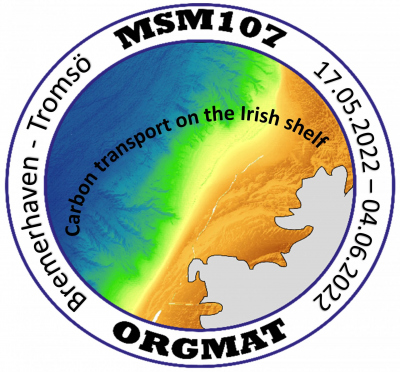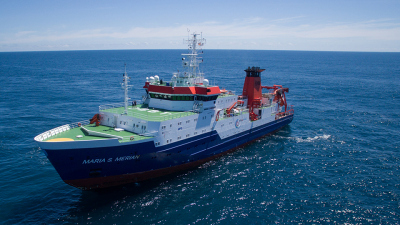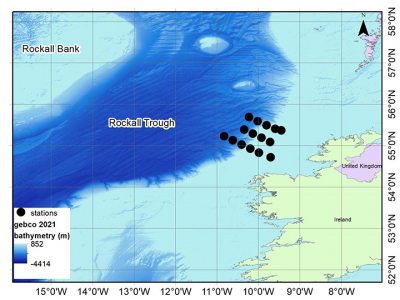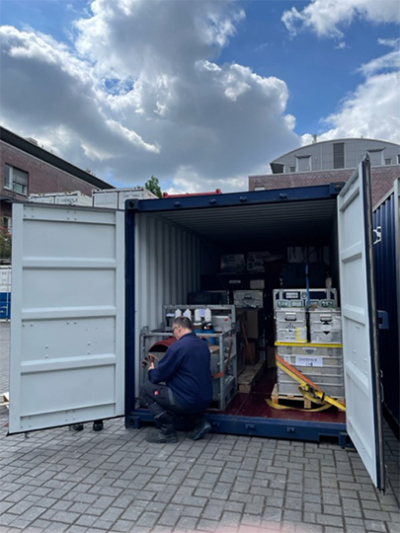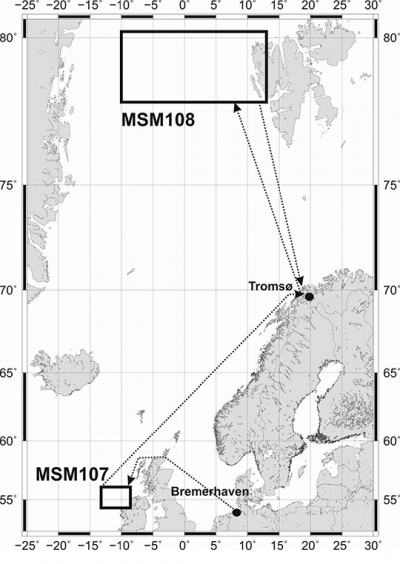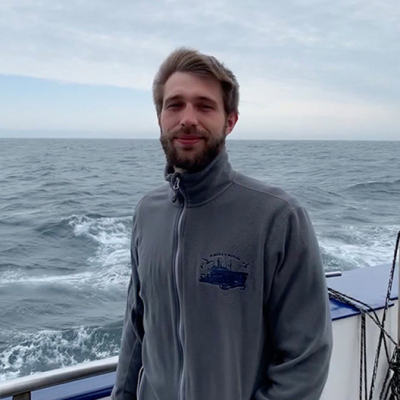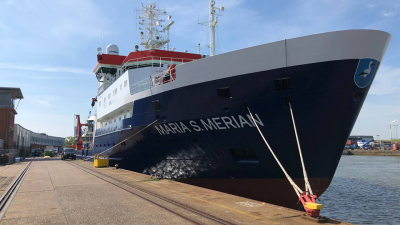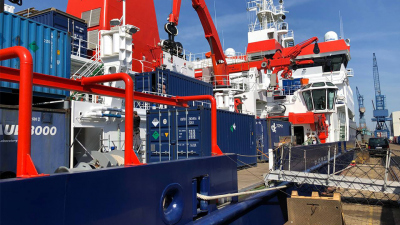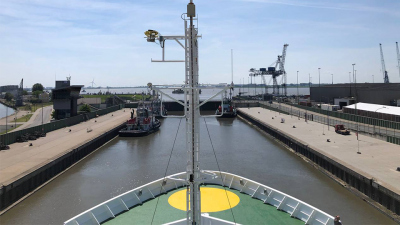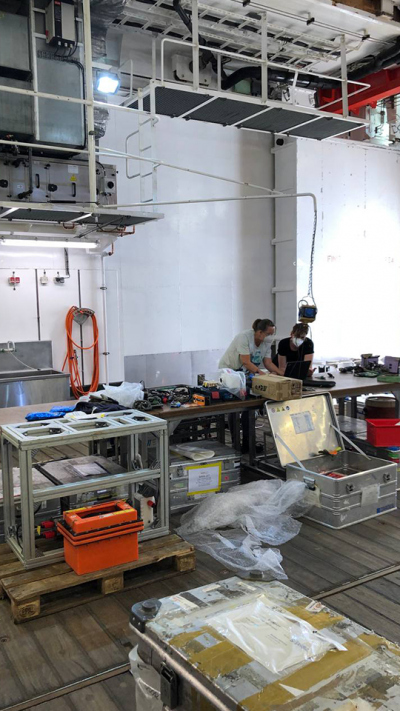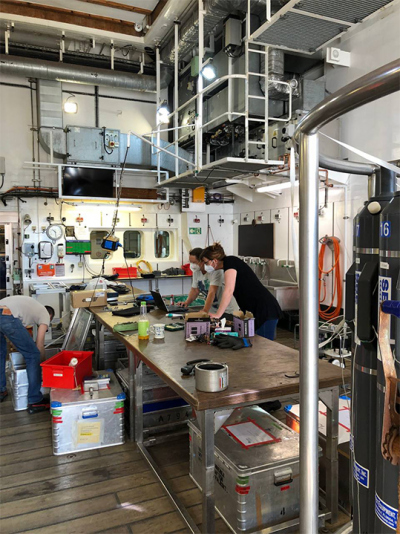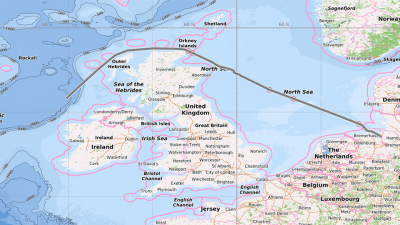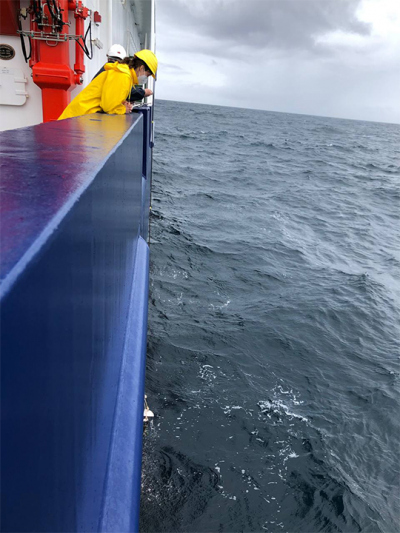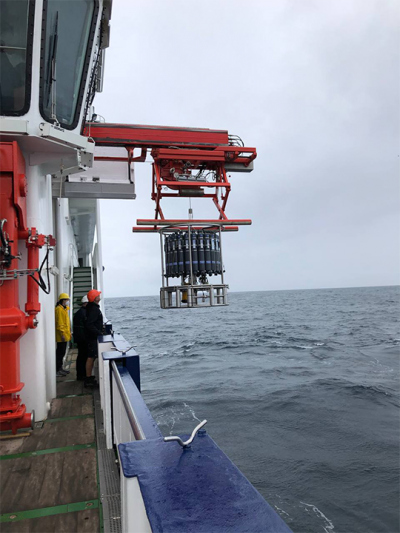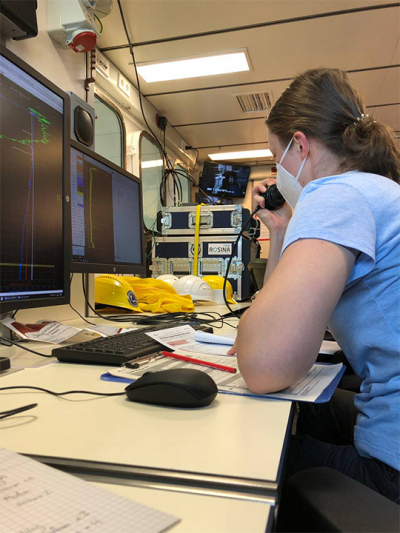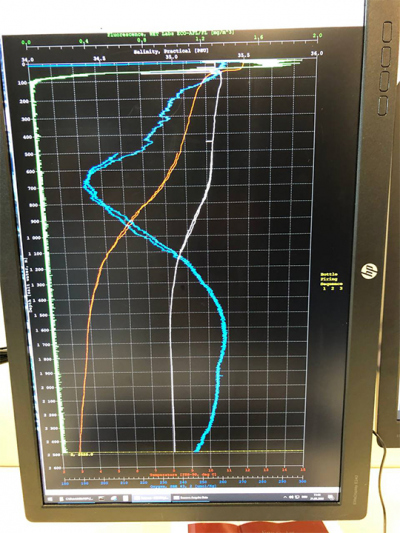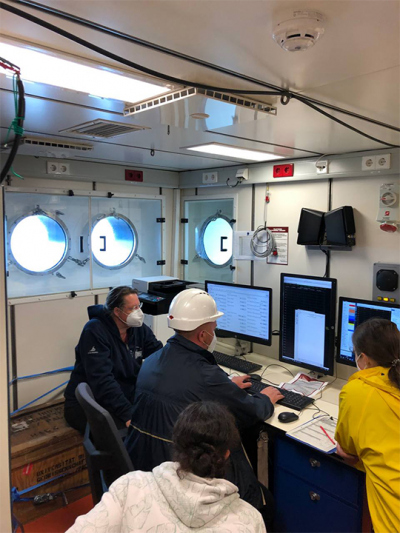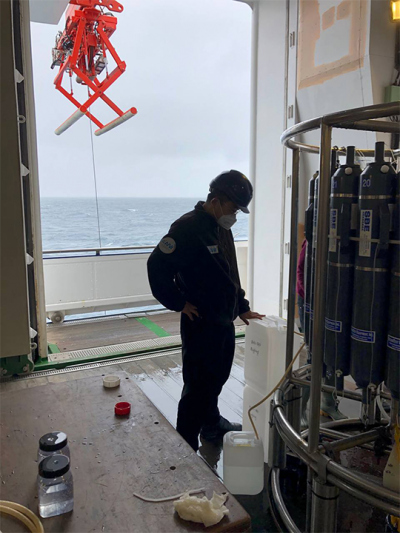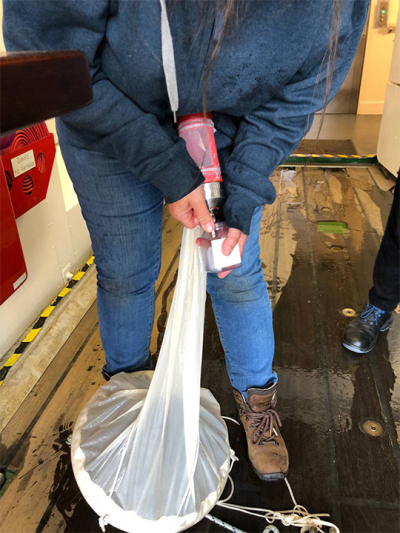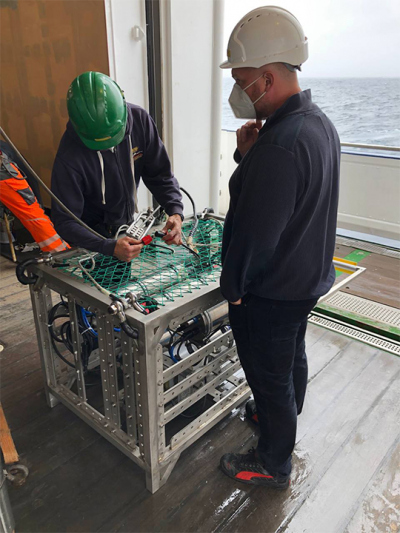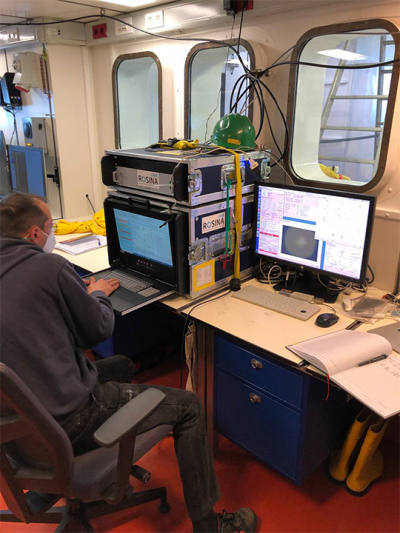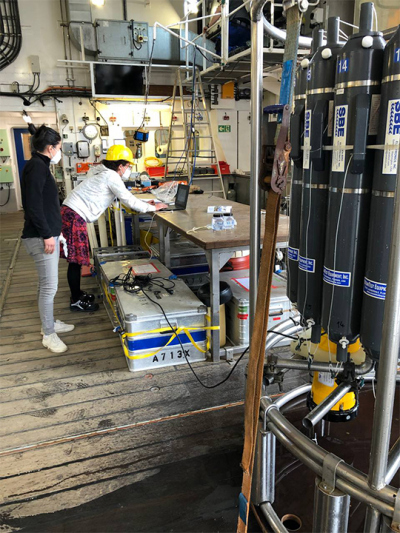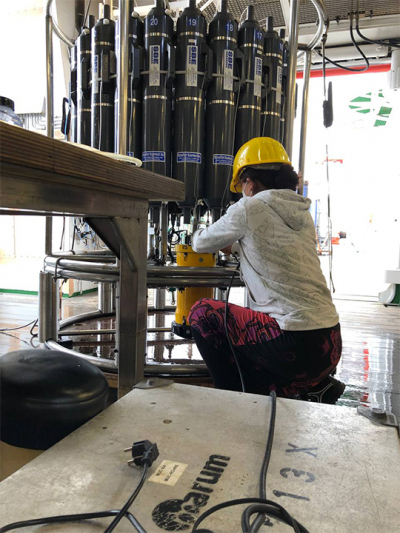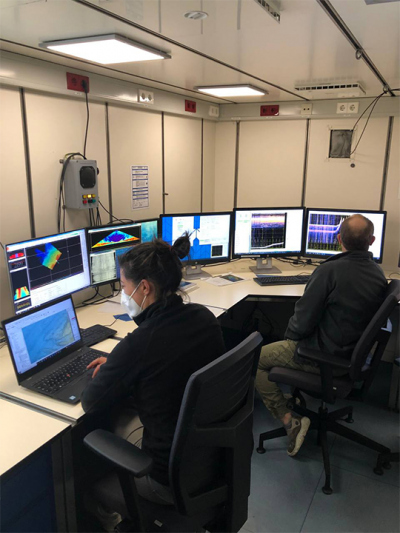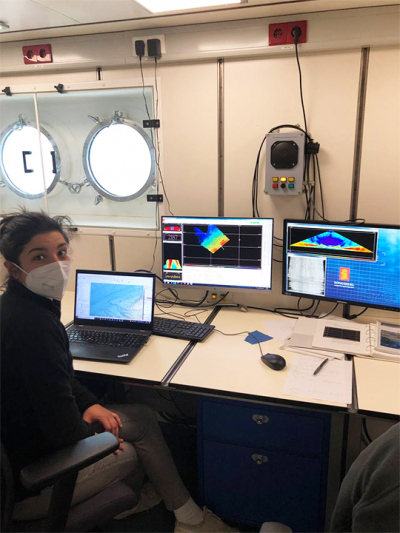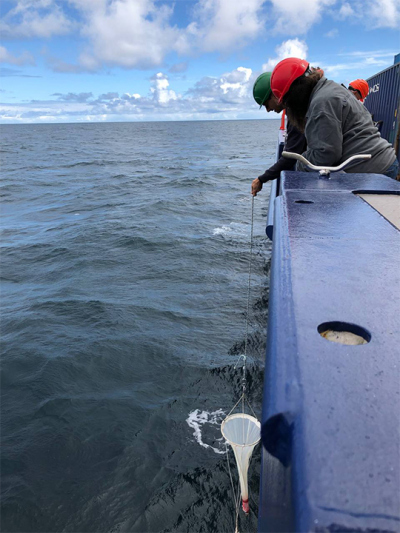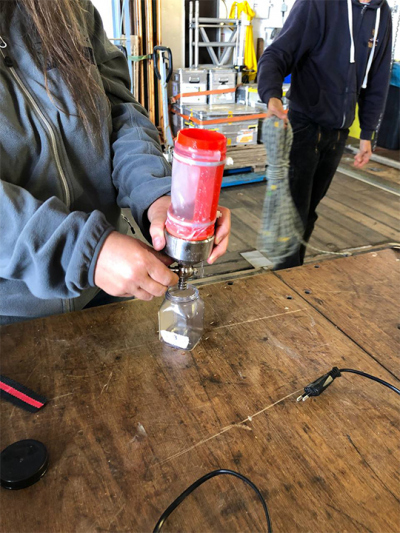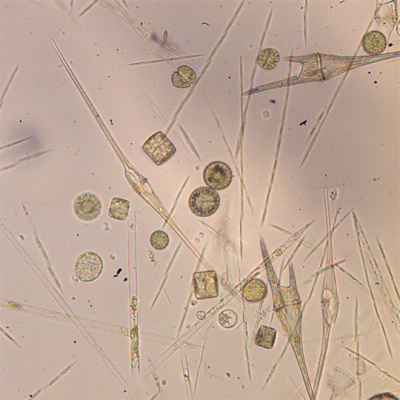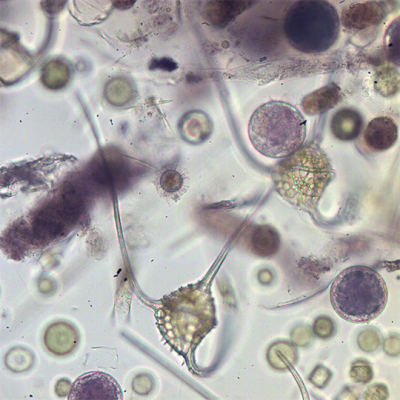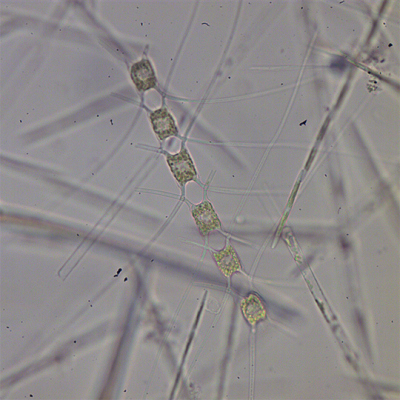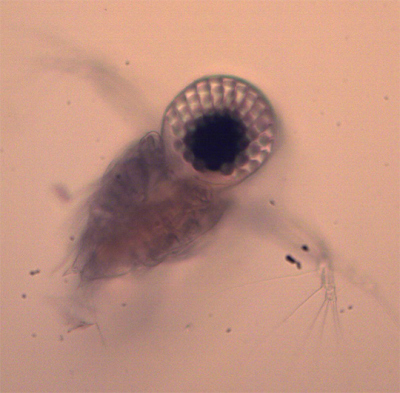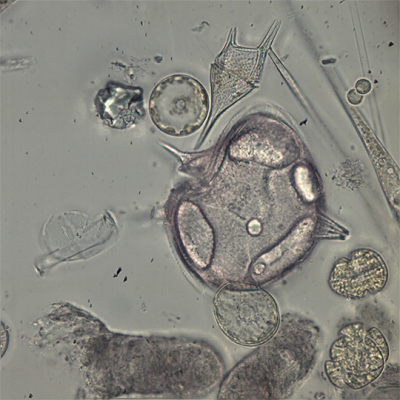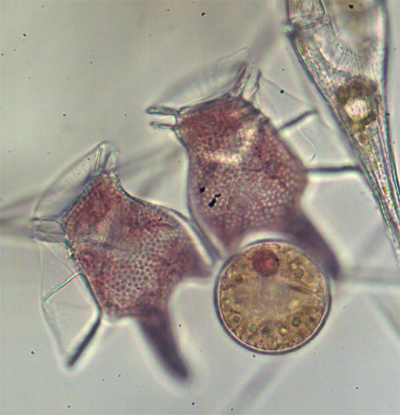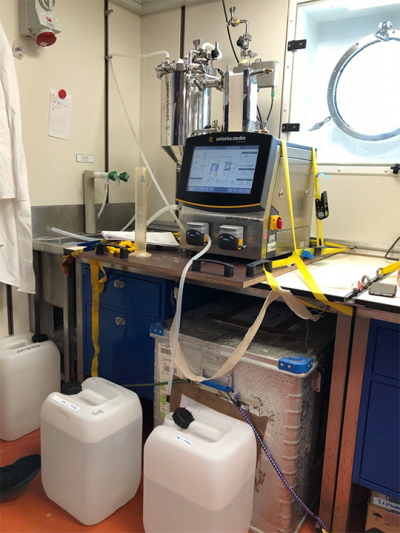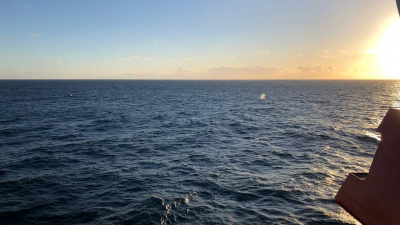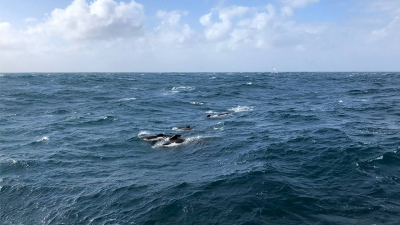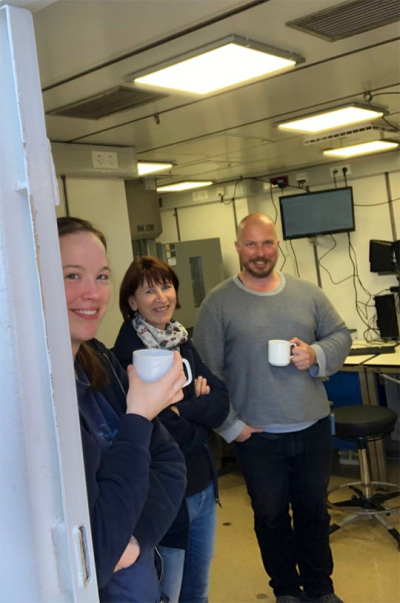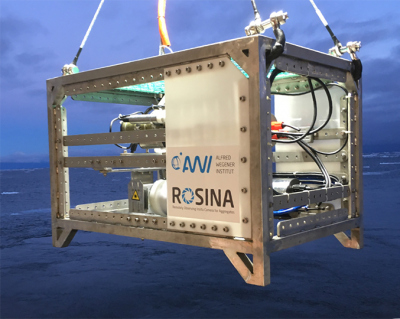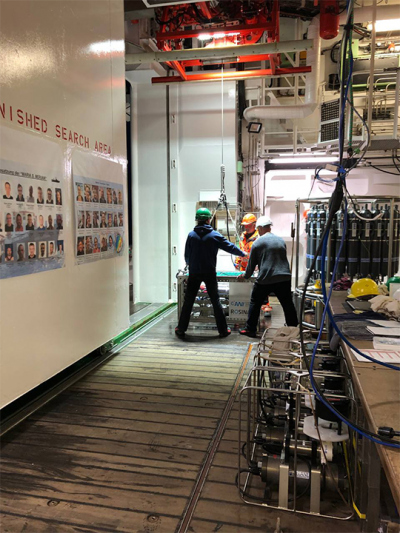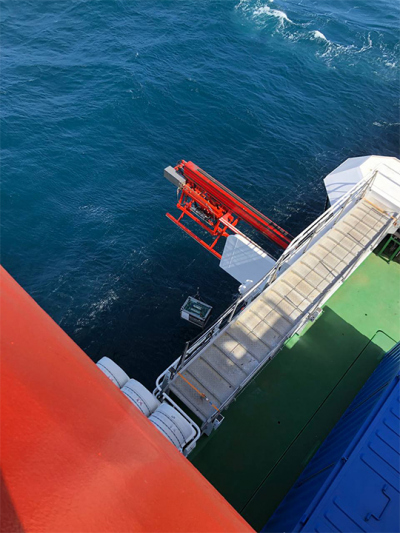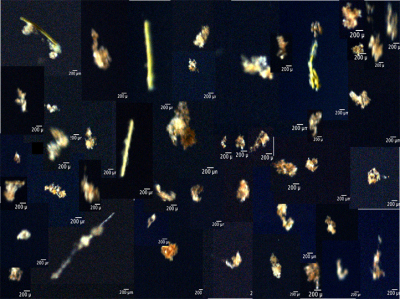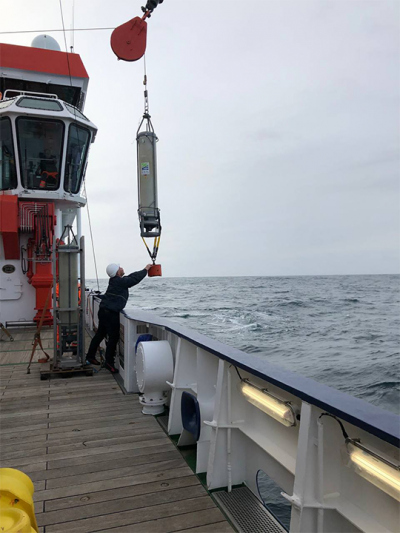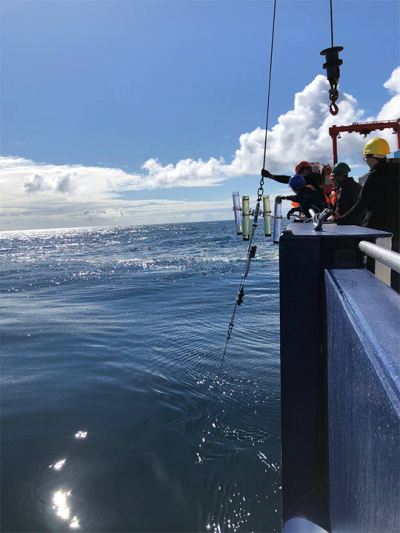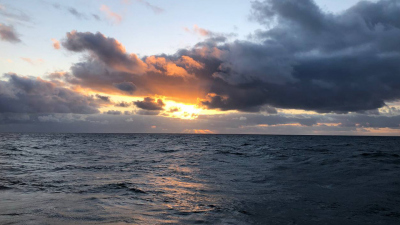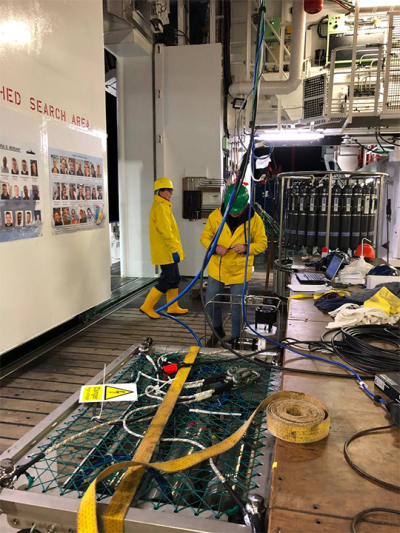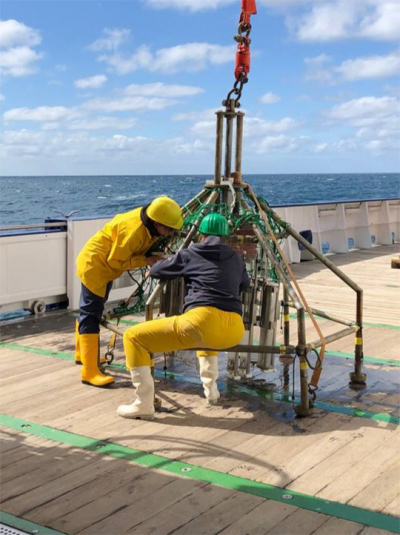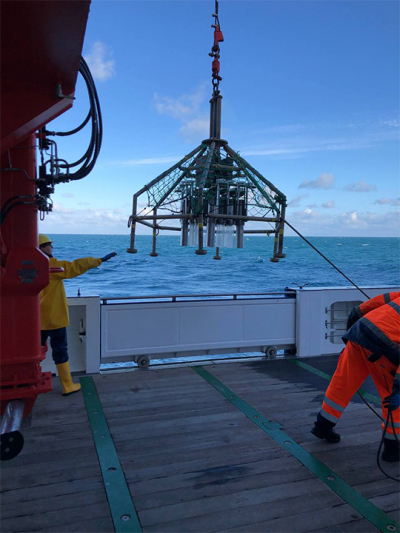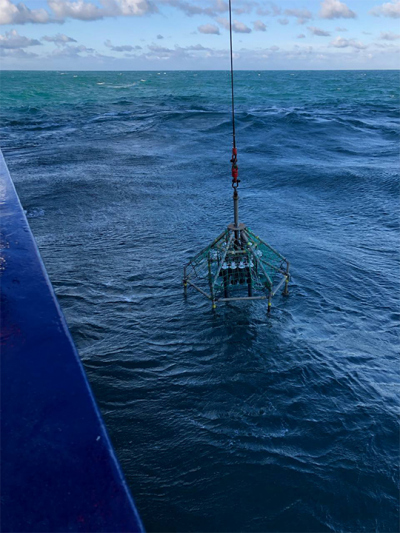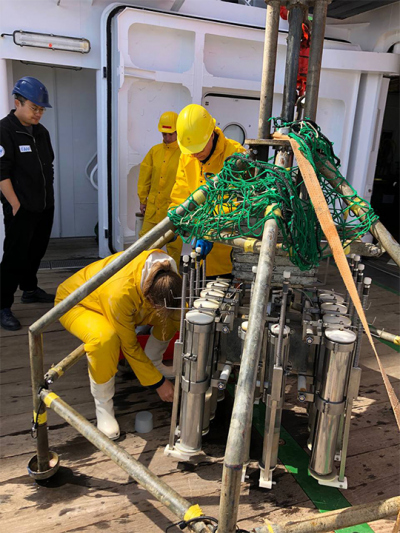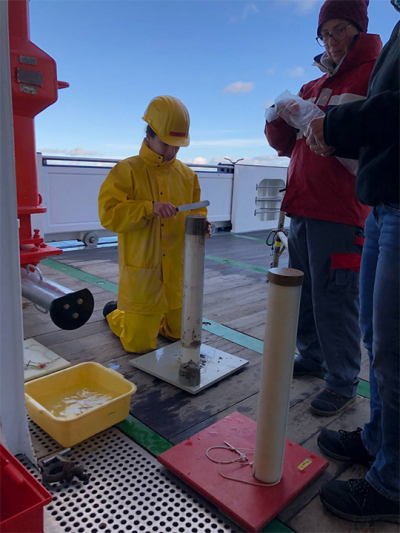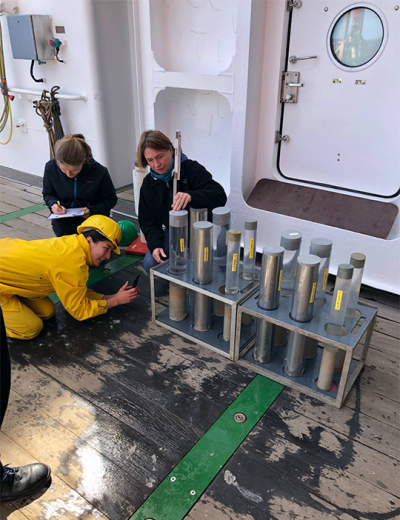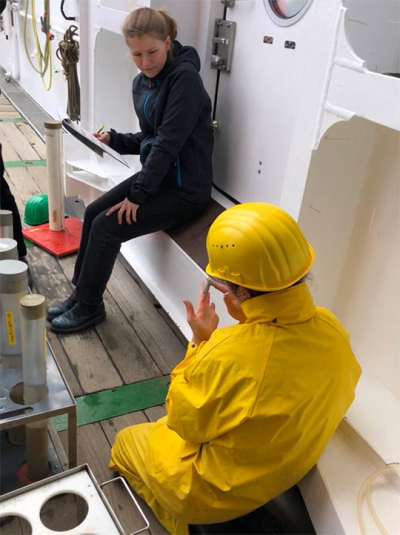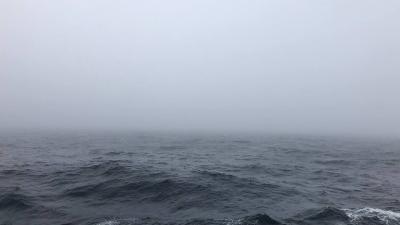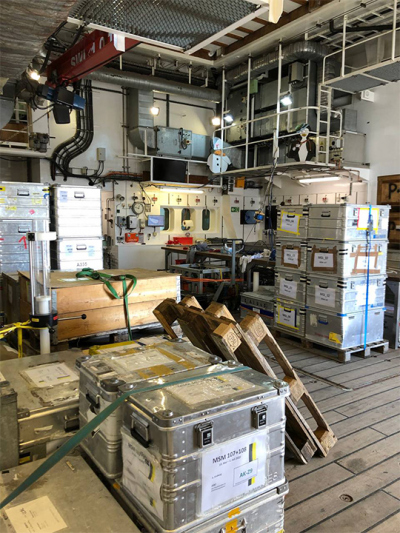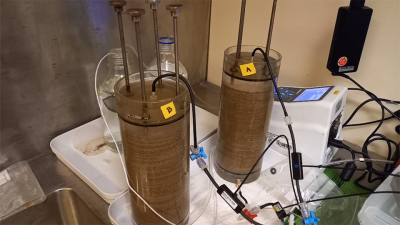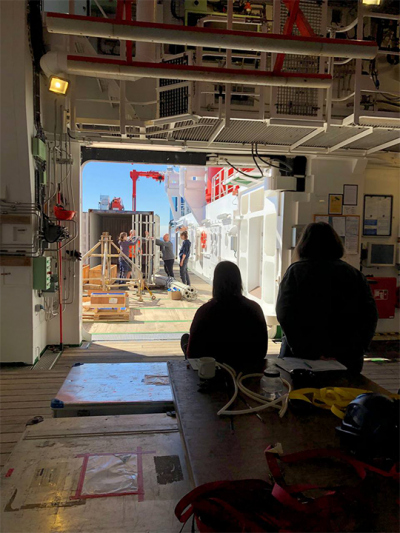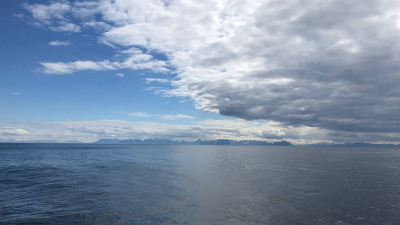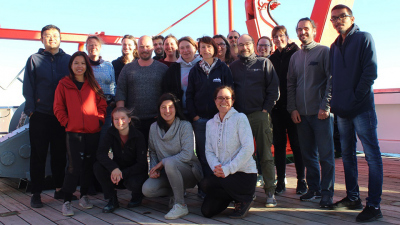- Home
- Discover
- Ship's logs
- Ship's log MSM 107
Ship's log MSM 107
On the formation, transport and transformation of organic material on and off the western Irish shelf: a blog about the research cruise of the RV MARIA S. MERIAN (MSM 107).
Researcher from MARUM – Center for Marine Environmental Sciences at the University of Bremen, Max Planck Institute for Marine Microbiology Bremen , University of Oldenburg, and Alfred Wegener Institute are currently getting ready to sail with the research vessel MARIA S. MERIAN to the ocean region off northwest Ireland. As part of MARUM’s Cluster of Excellence, The Ocean Floor – Earth’s Uncharted Interface, they are going to study how the ocean take up carbon dioxide from the atmosphere and store it in the deep ocean.
Recently the researchers discovered that a substantial fraction of organic carbon that was produced on the coastal shelf off northwest Africa was transported to and stored in the deep ocean. This could be an important mechanism that is mitigating anthropogenic carbon emissions. However, since studies that include both the coastal shelfs and the open ocean as well as the water column and the sediments are very rare, we do not know how important the transport of carbon from productive coastal areas to the deep sea are for carbon storage in the oceans.
With this sea-going expedition, the researchers will investigate the role of coastal production for deep ocean carbon storage in the northeastern Atlantic Ocean.
The ship's log of the RV MARIA S. MERIAN cruise MSM107 on the formation, transport and transformation of organic material on and off the western Irish shelf is written by Lennart Stock. Lennart is completing his Master's degree in Marine Environmental Science at the Institute of Marine Chemistry and Biology in Oldenburg, Germany. For the MSM107 ship's logbook, Lennart interviews researchers about their research on the RV MARIA S. MERIAN and writes about impressions and experiences on board the ship.
Tuesday, 17.05.2022
It is Tuesday morning at 9 am. We meet in front of the MARUM in Bremen. Anticipation and a little nervousness are in the air. We will spend the next 18 days on a ship collecting important research data necessary to better understand climate change. We continue by bus to Bremerhaven. First to the Alfred Wegner Institute to pick up the remaining researchers and then to the harbor. There the research vessel MARIA S. MERIAN is already waiting for us. The RV MARIA S. MERIAN is named after the natural scientist and artist Maria Sibylla Merian, who is famous for her impressive drawings and paintings of insects and plants.
There is already a bustle of activity on board the ship. The RV MARIA S. MERIAN has been in the shipyard for almost two months, but should be ready for departure the next day. In order to be allowed to work and live on the ship, there is immediately a safety briefing from Sören, our first officer. After all, safety is a top priority while aboard a ship. Fire is particularly dangerous. Once you're out on the open sea, it's not easy to call the fire department to put out the fire. This is also where Nilu, the ship's doctor and surgeon, comes in. Injuries can quickly occur on deck and the hospital is far away.
After the safety briefing, ship newcomers get a tour of the RV MARIA S. MERIAN. The ship is well equipped. In addition to various laboratories for scientific operations, there is a small hospital, a small grocery store, a gym and a sauna. In other words, everything you need to survive on the world's oceans.
After the tour, the container with the scientific equipment comes on board. Immediately, there is a bustle of activity among the researchers. Boxes are unpacked and equipment for research is set up. Everything has to be securely fastened, because the ship is always moving and even a small wave could knock the expensive equipment off the lab bench. And spare parts are also difficult to access on the high seas. In the evening of the day, we enjoy the setting sun from the palm deck and all fall tired into our bunks.
Wednesday, 18.05.2022 until Friday, 20.05.2022
The next day, the hustle and bustle on and below deck continues. Everything is getting ready for departure. Still full crates are cleared out and stowed empty in containers. When the last coat of paint and the last screw is attached to the RV MARIA S. MERIAN, we are ready to go. We leave the harbor through a floodgate and set course for our research area: the West-Irish Shelf Sea. If everything is according to plan, we will reach our destination on Saturday morning. Until then, we have to set up experiments and research equipment and prepare everything for their use.
Shelf areas are very dynamic due to wind-driven currents and high biological activity and therefore a particularly interesting place to do science. Phytoplankton, such as algae, use carbon dioxide (CO₂) and solar energy in surface water to convert it into organic material. This organic material describes everything that lives or once lived and consists mainly of carbon-rich compounds that form the building blocks of our lives. Organic material now sinks toward the ocean floor and enters the sediment or is transported by currents to deeper ocean regions away from the shelf.
Along the way, the organic material is altered by biological activity and partially converted back into carbon dioxide. This process is part of the carbon cycle, the study of which is important to better understand climate change.
In total, five groups, consisting of 19 researchers, from different research institutes and with different research interests want to study the formation, transport and transformation of the organic material in the West-Irish shelf.
While we are slowly approaching our first station, Thursday and Friday consist of further preparations and many meetings.
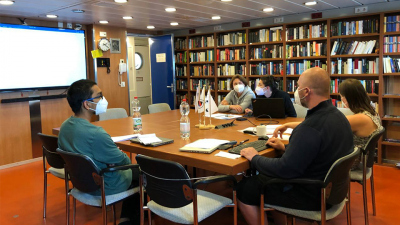
The individual groups of researchers need to discuss with each other, the groups of researchers need to discuss with each other, and then the researchers need to discuss with different crew members. All of these meetings are important so that when they arrive at the first station, everything runs smoothly and everyone knows what they have to do. Until the time comes, crew and researchers are already getting along with each other in a light swell.
Saturday, 21.05.2022
With record speed to the first research station off the West-Irish shelf
Entering the Atlantic Ocean and leaving the North Sea, which is often called a duck pond, wind and wave conditions change. Surfing on the tidal current, RV MARIA S. MERIAN reached a speed of 21.5 knots between Orkney and the Scottish mainland: a new record for this research vessel, which travels on average speed of about ten to twelve knots. While the RV MARIA S. MERIAN plows through the waves and starts rolling, some of the researchers experience contradictory sensory impressions. The human eye does not perceive the movement of the ship below deck, confusing the brain. The consequences are headaches and nausea. In strong swells, so-called seasickness brings many an experienced ocean explorer to his knees. But everything is only half as bad, because Nilu, our ship's doctor, is well prepared for this phenomenon. With appropriate medication, ship's zwieback and tea, all the explorers are soon on their feet again.
Finally, the time has come. We are off the Irish shelf at 12 o'clock on Saturday at our first research station. One after the other, various instruments are to be lowered into the water here to take measurements and collect water samples.
We start with the Secchi disc, which is lowered into the water by Morten, the chief scientist of the expedition, himself. A Secchi disk is a very simple but historically very valuable marine research device to measure the turbidity of the water. Thus, there is the longest data record in marine research from measurements made with the Secchi disk. It works in a very simple way. A black and white disc is lowered into the water until nothing can be seen of it. This depth is then given as the visibility, and from this the depth of visibility can be determined.
Next, it is the turn of probably the most important research instrument in oceanography. The so-called CTD rosette, which records conductivity, temperature, depth and other important parameters. This creates a profile of measured variables on the way towards the seafloor, giving researchers a good first impression of the station's water.
In addition to the CTD probe, there are 24 bottles arranged in a circle on the CTD rosette, which can be closed at any depth on the way back to the sea surface. In this way, water from different depths can be brought aboard the ship to conduct various experiments. In total, the CTD rosette needs almost two hours to get to the sea floor and back, because the sea off the Irish shelf is quite deep at 2500 meters.
But there is no time to take a deep breath. While the CTD rosette is still in the water, the next instruments are being prepared for their deployment. At this station, the plankton net, which captures everything larger than 20 micrometers (abbreviated: µm), such as small crustaceans, and ROSINA, a particle camera, are still on the program. But more about that later.
Saturday and Sunday, 21. and 22.05.2022
At the speed of sound to the shelf
Even before the first station has been declared finished, Elda, Alice, Tilmann, Britt and Renée are sitting excitedly in the EDP center of the ship, waiting for the FS MARIA S. MERIAN to finally start sailing towards the shelf again. In contrast to the rest of the research team, Elda, Alice, Tilmann, Britt and Renée mainly work with remote sensing and thus with devices that are firmly bolted to the ship. These devices use sound to scan the seafloor and the water column above it. This research area is called hydroacoustics and will be combined with sediment research on this cruise.
On the western Irish shelf, Elda and Alice, who both work in sedimentology at MARUM, and Tilmann, who is a geophysicist at the University of Bremen, want to follow the transport paths of particles into the sediment and also find out something about their whereabouts. This is because they also want to better understand how organic material is stored in shelf seas and in the ocean. In order to track the transport of particles, the researchers must first find out which currents prevail where. For this purpose, several areas, so-called transects, between the open ocean and the shallow shelf will be explored during the MSM107 cruise.
To get an overview of the ocean currents in this area, the researchers will use a so-called ADCP (ultrasonic Doppler profile current meter). With the ADCP, particle velocities can be measured using the Doppler effect down to a depth of 1500 meters, which in turn provides information about current velocities. In addition to the ADCP on board the FS MARIA S. MERIAN, Alice and Elda also have a small yellow ADCP permanently bolted to the CTD rosette. With this, the researchers can record a narrow, but much more accurate and also deeper current profile from the entire water column.
The measured current profiles are confirmed by Tilmann with a special focused echo sounder. This can be adjusted so that emitted sound is reflected by water layers with different densities. In this way, surface water can also be distinguished from deep water. At the same time, a different frequency of the echosounder can be used to look up to 100 meters deep into the sediment. As before in the water column, density differences in the sediment can be used here to distinguish sand from clay or other rock layers, for example.
Last, Elda introduces the multibeam echosounder, which measures the structure of the seafloor. The echo sounder allows the calculation of a three-dimensional image of the seafloor beneath the moving ship. This form of seafloor surveying is called bathymetry. In the meantime, it can be seen on the many screens of the EDP center that the seafloor is becoming shallower and shallower and that we are above the steep slopes of the shelf.
As we approach our first station on the western Irish shelf, many of the researchers have to crawl out of their bunks, having used the early evening hours to get some sleep. It is 12 o'clock in the night from Saturday to Sunday. By now, we have arrived on the shelf and again, the first CTD rosette of seawater is already back on deck. But the work has just begun. During the night and the next morning, water samples have to be processed again and various equipment has to be launched.
Sunday and Monday, 22. and 23.05.2022
After our first comprehensive station on the West-Irish shelf and the use of nearly all scientific equipment, the following experiments run well into the morning hours. Then, in the course of Sunday, a little calm returns. From 3 p.m., the mandatory wearing of masks also falls, after all persons on board the FS MARIA S. MERIAN have tested negative for Covid-19 over the first five days. As the weather continues to calm and the sun peeks out of the clouds from time to time, the deck comes alive. There is to be a barbecue in the evening to allow researchers and crew to get to know each other. This was previously hampered by mask and distance. The two excellent ship's cooks Matze and Georg as well as Silvia, our stewardess and "good soul" on board, serve up various salads and the finest grilled food. The food tastes delicious and everyone is happy to chat and enjoy the evening. Unfortunately, not everyone on board a research vessel like the FS MARIA S. MERIAN can spend the evening carefree. On the one hand, part of the crew must always be on call and on the other hand, such a ship must also be steered. Especially when the hydroacoustics research team wants to sail transects at a stable eight knots on the continental slope of the shelf during and after the barbecue.
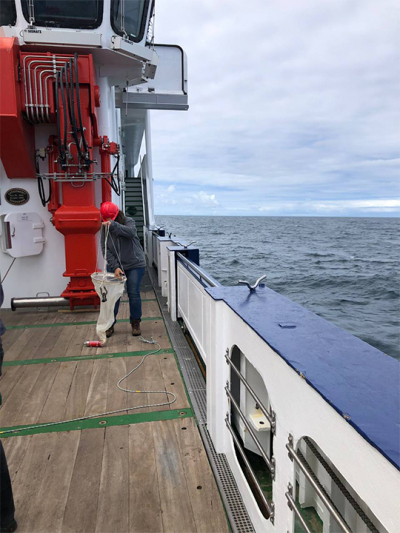
One scientific device that can still be launched by hand and without a winch, besides the Secchi disk, is the plankton net. Alex, our plankton expert from the Alfred Wegner Institute in Bremerhaven, pulls a net with a mesh size of 20 micrometers from a depth of 15 to 20 meters filled with microorganisms to the surface at each station.
On deck, the plankton sample is first filled into small containers using a small outlet at the bottom of the net. In the ship's deck laboratory, part of the sample is sifted alive and partially preserved with Formol, a chemical that preserves the plankton.
Marine scientists call plankton any living thing that moves through the water driven by the current rather than by its own propulsion. Alex is particularly interested in phytoplankton, the plant part of plankton that, like plants on land, needs light to live and grow. Phytoplankton is also known as microalgae and consists largely of so-called diatoms and flagellates, the latter of which are now known to require some species to actively ingest food for survival, so they are not plants at all.
It seems that Alex knows every single plankton species personally by name. Through a microscope, she looks at a certain amount of the plankton sample at a time to determine the species diversity there, as different plankton species can vary greatly geographically. After Alex identifies a species, she notes the name and snaps a photo. You can find a small selection of the plankton Alex found on and off the West Irish shelf as photos in this blog.
Tuesday, 24.05.2022
The sea is sweet
During the first major research station on the open ocean off the western Irish shelf, experiments in the laboratories of the FS MARIA S. MERIAN are in full swing. Aman, Nguyen and Lennart, who work at the Max Planck Institute for Marine Microbiology in the Marine GlycoBiology (sugar biology) research group, are in the wet lab searching for multiple sugars in the sea. Because the sea can also be sweet at times. Just as plants on land store energy in the form of starch, marine plants, like algae, store their energy in polysaccharides. Similar to how a cube of sugar dissolves in coffee, these polysaccharides also dissolve in seawater. Polysaccharides are found in the ocean in such small quantities that they must be concentrated, i.e. enriched, before researchers can study them.
When seawater is passed through a filter with micrometer-sized pores, the material left behind is what researchers call particulate (organic) material. Anything that can pass through this filter is called dissolved (organic) material. Polysaccharides are also part of the dissolved organic material. To separate salt and smaller dissolved compounds in the filtered seawater from the polysaccharides, Aman, Nguyen and Lennart brought a complicated-looking machine. This machine works on the principle of tangential flow filtration and separates all small from large dissolved organic compounds, as well as polysaccharides.
Aman, Nguyen and Lennart want to perform experiments with these polysaccharides: so-called incubations. In an incubation, they try to mimic the conditions in the ocean as closely as possible in order to then change individual environmental conditions in a controlled manner. In our case, the researchers want to determine how different amounts of polysaccharides affect the eating behavior of marine bacteria. This is because researchers have previously found that high amounts of polysaccharides can cause bacteria to stop eating altogether. This discovery could become interesting because it could keep bacteria and other marine organisms from converting the organic material into carbon dioxide. Thus, carbon could get out of the carbon cycle and be stored in the long term.
Wednesday, 25.05.2022
On the bridge of the RV MARIA S. MERIAN
Today, Wednesday, May 25, we are finishing the largest open ocean station to date. During the past 30 hours, all researchers and crew members have been working day and night. Samples were taken and all research equipment was in the water.
The procedure at a research station is first created by the chief scientist and then checked and approved by Captain Ralf for feasibility and permissibility according to the diplomatic approvals. Everything that happens on the ship goes through Captain Ralf and the bridge, where Senior Officer Ralf, 1st Officer Sören and 2nd Officer Bastian are on shift duty aboard the RV MARIA S. MERIAN.
The deployment of the research equipment is then coordinated from the bridge. Before we arrive at the research station, we will first "park" by hand to get the exact coordinates, but also a less wave-prone position of the ship. When we are on station, i.e. the ship is to hold the position, the bridge switches on the so-called "dynamic positioning". In this process, the POD drives align themselves with the propeler blades in such a way that the force of current and wind is perfectly balanced and the RV MARIA S. MERIAN remains in place. This is an important feature of a research vessel so that water and sediment samples can be taken within several hours at the same location. The RV MARIA S. MERIAN is very good at holding position, which provides us researchers with good samples. While Captain Ralf is in overall charge of the RV MARIA S. MERIAN, the engine is managed by Chief Engineer Benjamin and the deck by Boatswain Sebastian. Especially the communication and coordination between bridge and deck is important for the researchers on station, so that the station procedure is kept and the necessary safety is ensured when launching the equipment.
The day before, the "drift trap" was set. A sediment trap that drifts with the current and is collected again after about 24 hours. The drift trap sends out a GPS signal and can thus be located exactly. These coordinates are then entered into the navigation system on the bridge and the course of the RV MARIA S. MERIAN is aligned accordingly.
While we are sailing to the drift trap, some researchers are up on the bridge to ask Ralf and Sören some questions. To be allowed to sail as a crew member on sea, one way is to complete a training as a ship's mechanic (formerly sailor and engine keeper). After that, you can get a national patent at the maritime school, which qualifies you for further positions.
Apart from the official rules on board, there are also some customs, some of which you even take home with you. Even if you are not on duty. For example, it can happen that a shelf is chained up in one's own home to protect it from supposed swell. Although modern seafaring has almost nothing to do with the clichés of the old days, some peculiarities have survived. For example, "On deck, only the boatswain or the wind whistles," and an unburst champagne bottle at the ship's christening means bad luck.
When Christian, one of the researchers, discovers the drift trap, the excitement is great. Indeed, there is a competition on the bridge for the first sighting of equipment or targets. The drift trap is expertly navigated by Ralf and Bastian on the starboard side (i.e. on the right, for all non-seafarers) and then hoisted aboard by the explorers with a lot of help from the deck crew.
Thursday, 26.05.2022
From big to small
Over the past few days, researchers have been able to observe one of the largest creatures in the sea from the deck of the RV MARIA S. MERIAN. In the early morning hours, the lack of sleep seems to cause hallucinations in some researchers.
A water fountain in front of the rising sun out of the corner of the eye. But the impression is not deceiving. First, a whale watches the events aboard the RV MARIA S. MERIAN from a safe distance, blowing a small water fountain into the air from time to time. Then it approaches, briefly shows its back, dives just in front of the ship and has disappeared into the depths.
Some of the researchers are sad because they spent the morning hours in bed after working hard all night and were not allowed to watch this spectacle. Fortunately, their moods brighten up again in the afternoon. A large school of pilot whales, which belong to the dolphin family, pay a long visit to the RV MARIA S. MERIAN and playfully circle the ship.
The research objects that the group with Morten, Christian, Lilli, Sandra and Onur deal with could hardly be more different in size from the whales, although they are still directly related to them. The research group is looking for the very small objects in the sea: particles or "marine snow". In German marine snow. Research into these particles is important because they make a crucial contribution to carbon storage in the ocean. Organic material formed in surface water is transported to the deep sea and partially preserved there. Particles in the ocean can range in size from micrometers to meters, and consist of living and dead organic material, such as shells of dead algae, sugars, or the feces of larger creatures, such as whales. Particles, also called aggregates, are held together by sugar mucus, which many algae secrete, and are populated by all sorts of microorganisms and bacteria that live off the particles and slowly eat them.
When a particle is large and heavy enough, it begins to sink and starts its journey to the depths of the oceans. Morten, Christian, Lilli, Sandra and Onur use a variety of equipment to track down particles.
First and foremost, an in-situ camera that can determine the frequency and size of the particles directly on site and is called ROSINA. ROSINA stands for "Remotely Observing In-situ Camera for Aggregates". ROSINA has been developed and built by the Alfred Wegner Institute in Bremerhaven mainly by Christian and is equipped with state-of-the-art technology. ROSINA creates shadow images of the particles with a lot of light and a white background in a 200-millimeter area and captures particles down to 50 microns in size. A second light source, mounted at 90° to the camera, provides color information by illuminating particles and photographing them on a black background.
If ROSINA is now slowly lowered into the depths on a wire rope, it takes two pictures per second, giving the researchers a particle profile with the size and number of particles in the water column below the ship. Via a cable woven into the wire rope, Christian can view the images that ROSINA shoots directly in the laboratory of the RV MARIA S. MERIAN. This gives him a direct impression of what is going on beneath us.
In addition to a CTD sensor, there is another camera on ROSINA, the so-called "Jelly-Cam". This camera can be used to take environmental images of the water: These environmental images show the researchers what else is floating in the water besides the particles. In addition to ROSINA, Morten, Christian, Lilli, Sandra and Onur also have the drift trap for particles, and a "Marine Snow Catcher", with which a part of the water column can be sampled.
The drift traps consist of several vertical tubes deployed at different depths and filled with salt-enriched, now heavy seawater. When particles sink into the tubes, they can be examined by the researchers in the laboratory. Also attached to the drift trap is another in-situ camera, with a transparent tube, that allows measurement of the particles' sinking velocity.
Saturday and Sunday, 28 and 29.05.2022
From transport and degradation
We are approaching the end of the MSM107 research cruise. By now almost all research stations are behind us and we are heading for the last major station on the West Irish shelf. While we are on station, many gannets, fulmars, kittiwakes and skuas gather around the RV MARIA S. MERIAN. Presumably the birds are hoping for a quick bite of fish, which we cannot offer. So far only small snails, cold water corals or mussels came on board the ship with the sediment samples, but after a short observation they were immediately released back into their natural environment.
Two of the researchers who are mostly up at night are Karin and Nicole, who both work at MARUM. They are following the trail of organic material of known origin. This means that the researchers want to find out where the material formed by certain organisms, for example dinoflagellates and other plankton, reaches through currents and sinking and how much of it is degraded and where.
The degradation of this material is done by the very small organisms of the sea: the bacteria and archaea that feed and live on organic material. The speed of degradation depends on the prevailing environmental conditions in the surroundings. For example, bacteria and archaea find it difficult to eat organic material in oxygen-poor regions and easier in oxygen-rich regions. Both in the water column and in the seafloor, it can lead to low-oxygen conditions.
The degradation of this material is done by the very small organisms of the sea: the bacteria and archaea that feed and live on organic material. The speed of degradation depends on the prevailing environmental conditions in the surroundings. For example, bacteria and archaea find it difficult to eat organic material in oxygen-poor regions and easier in oxygen-rich regions. Both in the water column and in the seafloor, it can lead to low-oxygen conditions.
During decomposition, some of the organic material is converted to carbon dioxide, as it is in humans. Organic material, for example dinoflagellates, in the form of cysts or dead dinoflagellate shells, stick together to form aggregates or even particles. We call these aggregates and particles particulate organic material. These now sink driven by currents and gravity and are degraded in the seawater, but especially in the sediment.
Karin and Nicole can use various methods to determine which organism the organic material came from and how much of it has already been degraded. That's why the researchers sample the water column with four large in-situ pumps that filter between four hundred and one thousand liters of water and deposit the particulate organic material on a large filter. Because much of these particles end up in marine sediment, the researchers also take sediment cores using a device called a multicorer, or MUC.
On the MUC there are eight large and four small tubes made of metal and hard plastic slightly sharpened on the walls. As soon as the frame of the MUC with the tubes sinks into the seafloor, a sophisticated mechanism is triggered and a small flap snaps shut, sealing the tubes tightly. As it is pulled up, the trapped sediment can no longer slip out the bottom due to a sustained vacuum. However, for safety, another shutter is closed at the bottom of the tubes as soon as the MUC is pulled out of the seafloor. Sometimes it happens that the sediment is too hard or the device touches down crookedly on the seafloor. Then, unfortunately, the researchers come up empty.
What is special about the MUC sediment cores is that not only sediment, but a layer of water can be brought on deck in the tubes. The first few centimeters of the sediment and the layer of water above it are, in fact, of particular interest to the researchers. This is where most of the decomposition of organic material takes place. The sediment cores are now measured on deck and removed in centimeter-thin layers so that they can later be measured individually and analyzed in detail. Not only Karin and Nicole are interested in the sediment and the cores are divided sisterly among the researchers.
Recently, Karin and Nicole have been researching the transport and fate of plastic in our oceans, in addition to the organic material of known origin. Plastic is introduced into the oceans by humans in a wide variety of forms. Larger pieces of plastic are transformed into smaller, so-called microplastics in the surface water mainly by sunlight, i.e. UV radiation. Like particles of organic material, microplastics sink to the bottom of the ocean through currents and gravity. But what happens to the plastic in the sediment is largely unexplored.
Tuesday to Saturday, 31.05. to 04.06.2022
Not only carbon
We have finished our last stop and are about to leave the research area for Tromsø, where researchers of the next exit will replace us. Since the hydroacoustics researchers are still measuring as long as they are allowed to, the RV MARIA S. MERIAN initially sails at eight knots. Only at the border of the research area, the measuring instruments will be turned off, until the RV MARIA S. MERIAN has reached international waters.
Now the research vessel also picks up speed. In territories of other nations, such as the West-Irish shelf, a research permit must always be obtained in order to be allowed to conduct research. As the last experiments are slowly being completed, many are already beginning to pack their boxes. Materials and expensive research equipment are stowed tightly and securely for transport in the designated crates. The crates are stacked on pallets for mooring on the deck of the RV MARIA S. MERIAN.
So while most of us are already packing our boxes, there are still three researchers who are still in the middle of their experiments. Hannah, who is doing research at MARUM and the Max Planck Institute for Marine Microbiology, Jördis, who is working at the Max Planck Institute, and Bingbing, who is doing research at the Alfred Wegner Institute, can still be found in the cold laboratories below deck of the ship at a pleasant 4 and 12 °C. Hannah and Jördis, unlike most of the other researchers here on board, are not only researching the element carbon and the carbon cycle, but also nitrogen and the nitrogen cycle in the ocean.
Nitrogen enters the ocean through rivers and precipitation in the form of various compounds, such as ammonium, nitrate and nitrite, and in nitrogen-containing organic compounds. Elemental nitrogen (N2) is also taken up directly from the atmosphere by so-called diazotrophic
(nitrogen-loving) microorganisms and converted into nitrogen compounds biologically available to other organisms. Absorbed by microorganisms, nitrogen compounds and nitrogen-containing material are now distributed through the food web in the oceans. This is also how it reaches the seafloor and sediments, largely as particulate organic material. In the sediments, the organic nitrogen is either converted into elemental nitrogen or nitrate by bacteria and archea, or it is deposited in the long term. These intercalations can sometimes still be detected after hundreds of thousands of years and give us important clues about the climate of past times.
Hannah is researching the processes of conversion of nitrogenous compounds in sediments. On this research trip, she is particularly interested in sandy sediments. Sandy sediments differ from others in that they are very well aerated in the first few centimeters and are well flushed by currents. Jördis is working directly with Hannah by looking at the processes involving nitrogen in the water column above the sediments.
The researchers want to understand the ways in which nitrogen-containing compounds formed on the western Irish shelf change and degrade as they are transported to deeper parts of the ocean in the water, as well as in the sediment. Bingbing's research is similar to Hannah's and Jördis'. Bingbing is looking at the change and degradation of organic compounds in sandy sediments. However, again focusing on carbon and the carbon cycle. To do your research, Hannah, Jördis and Bingbing need to get to the sandy sediment. Here, the hydroacoustics researchers can provide crucial clues, as they can sense the soil properties with their instruments. Like other researchers before them, Hannah, Jördis and Bingbing take sediment cores using the MUC.
But Hannah also has the Van Veen grab with her to bring large amounts of sandy sediment aboard the RV MARIA S. MERIAN. The Van Veen grab is built like a dredge bucket and closes on contact with the bottom. With plenty of sandy sediment on board the ship, the important measurements can now be made. Hannah and Jördis first measure ammonium, nitrate and nitrite concentrations. Then they add ammonium themselves and follow how ammonium becomes nitrate. Bingbing additionally measures the oxygen saturations in the sediment cores. The decomposition and change of the organic material is decisively influenced by oxygen.
While Hannah, Jördis and Bingbing are handling sandy sediments below deck, the other researchers are already slowly starting to put things together and pack boxes. Again, there is a lot of confusion. But this soon subsides as the researchers get a lot of support from the deck crew.
In the night from the first to the second of June, the RV MARIA S. MERIAN stops briefly in international waters. Christian lowers ROSINA one last time to previously unimagined depths of almost 3000 meters.
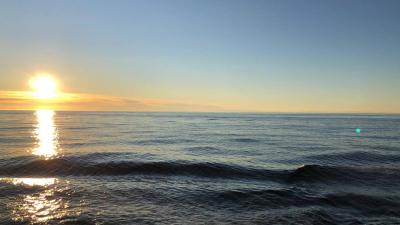
Afterwards, Captain Ralf and his crew set course for Tromsø. In doing so, we also cross the Arctic Circle. What is everyday life for polar explorers in summer comes as a surprise to some of them. The sun no longer sets here, and even at midnight the deck of the RV MARIA S. MERIAN is bathed in golden light.
It is Friday, the third of June, and the coast of Norway is in sight. We are about to enter Tromsø via a fjord and spend one last night on the RV MARIA S. MERIAN. The next morning, most of the researchers head back to Germany and return to their less adventurous daily work routine after a successful and exciting cruise.
At this point, the researchers would like to express their sincere thanks to the crew of the FS MARA S. MERIAN, without whose active support this cruise, but also marine research in general, would not be possible. A big thank you also goes to the cooks Matthias and Georg and our stewardess Sylvia, who made our stay on the RV MARIA S. MERIAN as pleasant as possible, both in terms of cuisine and hospitality. At the end we would also like to thank our readers. See you next time. Ahoy!



